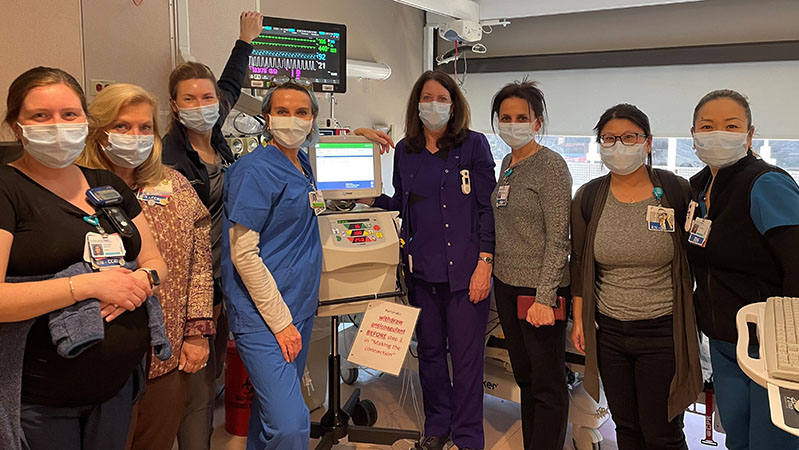Notice of privacy incident at Brigham and Women's Faulkner Hospital Learn More
Header Skipped.
Notice of privacy incident at Brigham and Women's Faulkner Hospital Learn More
Header Skipped.

The ICU team with the CVVH machine; from left: staff nurse Meaghan Boulger, MSN, RN, CCRN, Program Director for Informatics for Nursing/Patient Care Services Paula Wolski, MSN, RN-BC, staff nurse Sarah McRoberts, BSN, RN, Interim Chief of Nephrology Adina Voiculescu, MD, FASDIN, Clinical Leader Ellen McCarthy, DNP, MSN, RN, CCRN, Nurse Director for the ICU, Dialysis and Respiratory Estier Sayegh, MBA, BSN, RN, CNRN, PCCN, CCRN, ICU Professional Development Manager Meigan Amaral, MSN, RN, CCRN, and staff nurse Yoko Davis, BSN, RN
In the past, patients in Brigham and Women’s Faulkner Hospital’s ICU with acute or chronic renal failure who were not a good candidate for hemodialysis, were transferred to Brigham and Women’s Hospital for a specialized treatment known as continuous veno-venous hemofiltration (CVVH). Now, thanks to on-going championing by the providers and nursing staff in the ICU, CVVH is available onsite at BWFH, meaning patients can get the level of care they need, delivered safely in Jamaica Plain.
Adina Voiculescu, MD, FASDIN, Interim Chief of Nephrology at BWFH, specializes in renal replacement therapy. “For patients with renal failure, there are several treatment options, including hemodialysis and peritoneal dialysis. Both of these options are done intermittently,” she says. “But for critically ill patients, a gentler process is needed. That’s what makes CVVH so special. It’s done over a 24-hour period right at the bedside under ICU nursing care.”
Unlike hemodialysis and peritoneal dialysis, which are long-term options, CVVH is a temporary treatment intended to provide life-saving renal replacement therapy for a short period of time until the patient’s kidney function recovers (in the case of acute kidney failure) or until the patient is well enough to tolerate intermittent hemodialysis or peritoneal dialysis.
“In the ICU, we treat very ill patients. We see acute renal failure mostly in patients with sepsis and heart failure,” says Nurse Director for the ICU, Dialysis and Respiratory, Estier Sayegh, MBA, BSN, RN, CNRN, PCCN, CCRN. “Before we had CVVH available, we would send these patients to the Brigham for treatment. Traveling just four miles over to Longwood can be very taxing for someone so ill. In addition, the acuity and volume in area ICUs has been increasing over the past several years. It only adds pressure to the academic medical centers’ ICUs if we send our patients to them for CVVH. Doing it in-house here at BWFH helps alleviate some of that pressure.”
Both Dr. Voiculescu and Sayegh credit the nursing staff for making this treatment option a possibility at BWFH. Their willingness to embrace the program and learn the process is what made it possible. “It’s something we’ve always wanted to do in the ICU,” says Clinical Leader Ellen McCarthy, DNP, MSN, RN, CCRN. “It’s all about providing the best possible patient-centered care. They can stay right where they are and get the care they need. In the future, we also hope to be able to take patients from the Brigham and other local hospitals via our access center in order to ensure every patient who needs this level of care can get it when they need it.”
For the nursing staff, providing CVVH required specialized education and the willingness to learn. “All of our permanent nursing staff participated in a training session with the CVVH machine manufacturer where we learned how to set up the machine and connect the patient to the machine. Our current dialysis staff under the leadership of Paul Moore, RN has also been trained on this different type of renal replacement therapy. We’ve also had to learn the theory behind the process and develop specialized documentation,” says ICU Professional Development Manager Meigan Amaral, MSN, RN, CCRN.
“CVVH requires one-to-one nursing,” says Sayegh. “It’s labor intensive and requires critical thinking from nursing, but my staff has proven they are more than up to the challenge. I am beyond proud of the level of collaboration, teamwork and commitment to patient-centered care that they have demonstrated in order to make this all possible.”
Published 6/8/23
Looking for more news from BWFH? Go to News to find articles about health, updates to our programs and services and stories about staff and patients.
Go to News